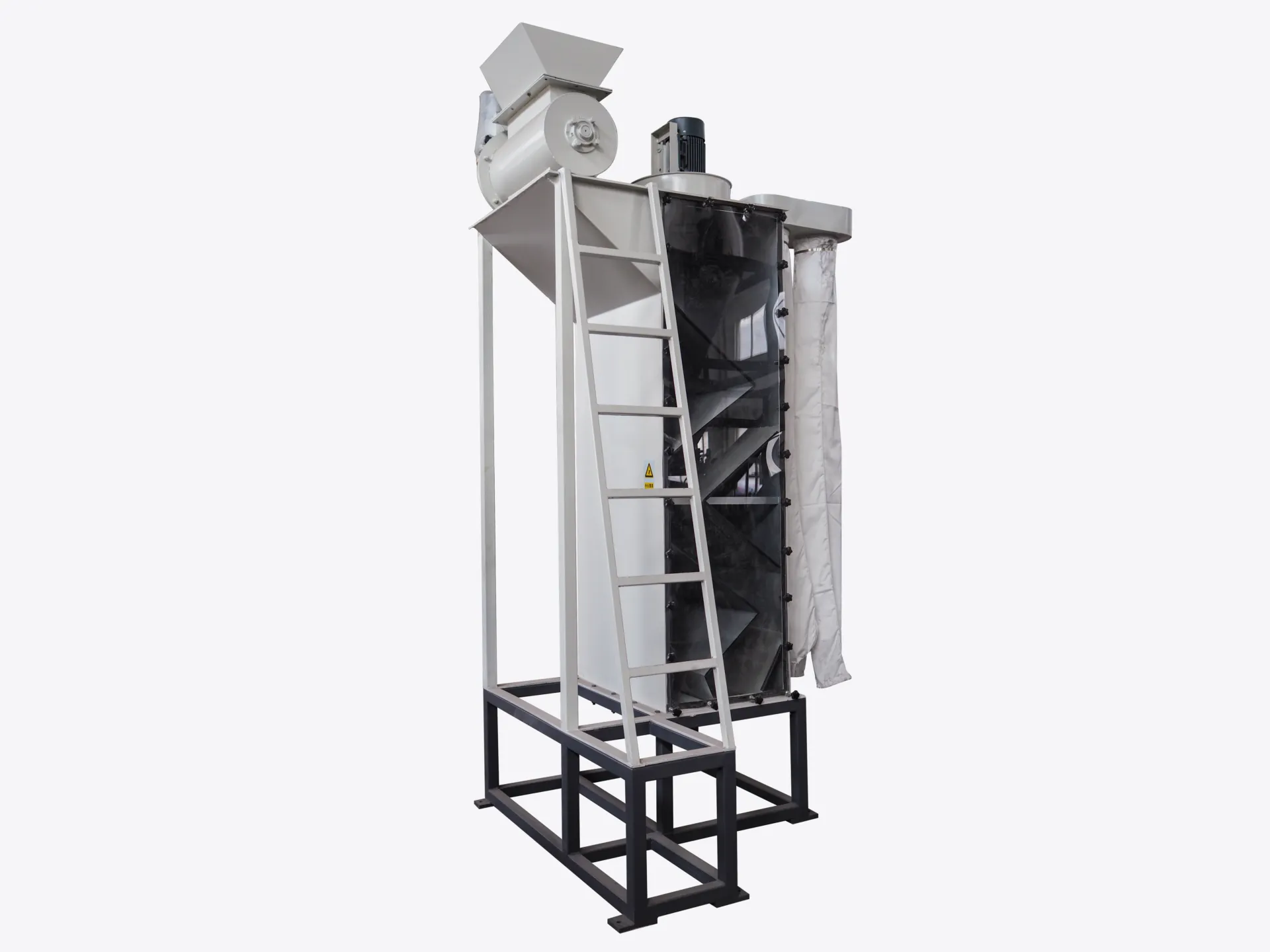Ve složitém světě recyklace plastů je konečná kvalita recyklovaného materiálu prvořadá. Dosažení této čistoty vyžaduje řadu sofistikovaných procesů, které jsou navrženy tak, aby odstranily veškeré stopy kontaminace. Zatímco drtiče, pračky a sušičky jsou často v centru pozornosti, v pozadí tiše pracuje klíčové a důmyslné zařízení: Klasifikátor vzduchu Zig-Zag, také běžně známý jako Oddělovač štítků nebo Odlučovač vzduchu v recyklačním průmyslu.
Tento stroj je mistrem v separaci, protože k čištění plastových vloček využívá jednoduchý, ale vysoce účinný princip. Tento článek poskytuje podrobný úvod do toho, co to je, proč je nezbytný a jak přispívá k úspěšnému cirkulárnímu hospodářství.
Co je to cikcakový vzduchový klasifikátor?
Cikcakový vzduchový třídič je mechanický separátor, který třídí materiály na základě jejich různé hustoty a aerodynamických profilů. Jeho charakteristický název pochází z jeho hlavní součásti: vysokého, vertikálního kanálu konstruovaného v klikatém vzoru. Funguje bez vody, což z něj činí klíčovou součást „suché“ separační fáze v moderní recyklační lince.
Jeho primárním využitím v plastikářském průmyslu je odstraňování lehkých kontaminantů – konkrétně papírových a plastových fóliových etiket, ale i prachu a jemných částic – z proudu těžších, drcených plastových vloček (jako je PET, HDPE nebo PP).
Klíčová role oddělení štítků
Po sesbírání plastových lahví a jejich rozdrcení na vločky vzniká heterogenní směs. Obsahuje cenné plastové vločky, ale je silně kontaminována zbytky etiket z výrobků, víček a jemným prachem vzniklým při drcení.
Pokud tyto kontaminanty nebudou odstraněny:
- Ohrožují kvalitu finálních recyklovaných plastových pelet, což vede ke změně barvy, strukturálním slabinám a problémům se zpracováním.
- Mohou hořet a rozkládat se během fáze tavení a extruze, uvolňování výparů a vytváření černých skvrn v konečném produktu.
- Snižují tržní hodnotu recyklovaného materiálu, protože výrobci vyžadují vysoce čistou vstupní surovinu.
Klasifikátor Zig-Zag Air je první linií obrany proti tomuto typu kontaminace a funguje jako brána kontroly kvality, která zajišťuje, že do další fáze postupují pouze čisté vločky.
Jak to funguje: Podrobný rozbor
Genialita vzduchového klasifikátoru Zig-Zag spočívá v elegantním využití gravitace a proudění vzduchu. Proces lze rozdělit do pěti klíčových kroků:
- Přísun materiálu: Smíšený proud plastových vloček a etiket je přiváděn do násypky na samém vrcholu stroje.
- Kaskádový efekt: Z násypky materiál padá do komory s klikatým tvarem. Úhlové přepážky nutí materiál se při sestupu valit a kaskádovitě převalovat ze strany na stranu. Tato činnost je zásadní, protože rozbíjí všechny hrudky a zajišťuje, že každá částice je jednotlivě odkryta.
- Protiproudné proudění vzduchu: Současně výkonné dmychadlo nebo ventilátorová jednotka žene komorou přesně řízený sloupec vzduchu směrem nahoru, který proudí proti padajícímu materiálu.
- Separace v akci: Tady se děje ta magie.
- Ten/Ta/To těžké plastové vločky mají dostatečnou hmotnost k překonání vzestupného tlaku vzduchu a pokračují ve své padákové cestě dolů k dolnímu výtoku.
- Ten/Ta/To lehké kontaminanty (papírové etikety, plastová fólie, prach) mají velký povrch a nízkou hustotu. Snadno je zachytí vzestupný proud vzduchu a vynesou se z hlavního proudu materiálu.
- Dvojité vybíjení: Stroj má dva samostatné výstupy. Vyčištěné, těžké plastové vločky se vypouštějí zespodu a jsou připraveny k dalšímu zpracování. Lehké kontaminanty jsou vzduchem odváděny samostatným otvorem na boku nebo v horní části stroje, kde se shromažďují ve filtračním sáčku nebo cyklonovém systému k likvidaci.
Klíčové komponenty a konstrukční prvky
Jak je vidět v typickém návrhu, klasifikátor se skládá z několika základních komponent:
- Vstupní násypka: Místo, kde směsný materiál vstupuje do systému.
- Separační komora Zig-Zag: Srdce stroje, navržené pro maximalizaci rotace materiálu a vystavení vzduchu.
- Ventilátor/dmychadlo: Motor procesu, který zajišťuje nastavitelný proud vzduchu směrem nahoru.
- Systém sběru kontaminantů: Výstupní otvor připojený k velkému ponožkovému filtru nebo cyklonu pro zachycení oddělených lehkých frakcí.
- Výstup čistého materiálu: Trychtýř ve spodní části, kudy vycházejí vyčištěné vločky.
- Podpůrný rám a přístup: Robustní ocelový rám pro podepření svislé konstrukce, často včetně žebříku pro přístup při údržbě.
Závěr: Nepostradatelný přínos pro kvalitní recyklaci
Ačkoli se to může zdát jednoduché, cikcakový vzduchový třídič je důkazem brilantního inženýrství. Využíváním základních sil gravitace a vzduchu plní nepostradatelný úkol s vysokou účinností, nízkou údržbou a minimální spotřebou energie. Je to klíčová investice pro jakoukoli seriózní recyklační operaci, která přímo přispívá k výrobě vysoce kvalitních a cenných recyklovaných plastů a posiluje základy cirkulární ekonomiky. Je bezpochyby jedním z neopěvovaných hrdinů moderní recyklační linky.



